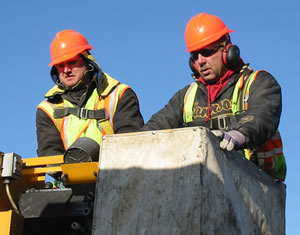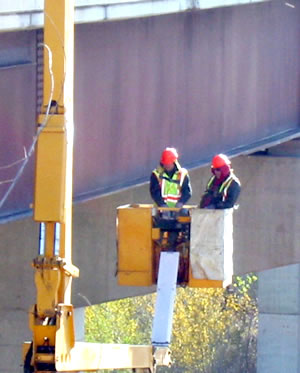By Donna Lindberg

Mike Anderson and Scott Tyson, senior transportation generalists, get ready to repair the Hwy 49 High Bridge in St. Paul from a “snooper” bucket. Photo by Donna Lindberg |
Editor’s note: With this issue, Newsline begins a new series that will feature Mn/DOT employees on-the-job. Do you or a co-worker have an interesting job to share with readers? Use the “Submissions” button on the left navigation bar, or click here to send us your ideas, and we’ll contact you for more information.
On a recent mid-November day, a Metro District bridge maintenance crew was out on the Hwy 49 Smith Avenue High Bridge to inspect the bridge deck. Measuring 2,760 feet long, the High Bridge has 11 spans and stands 200 feet above the Mississippi River at the bridge’s south end.
To perform the inspection work, Mike Anderson and Scott Tyson, senior transportation generalists from the Mendota Resident Maintenance Office, use a Reach-All truck with a flexible arm and a bucket at the end. The truck is also called a “snooper” because it allows crews to inspect the hard-to-reach underside of bridges. During inspection, the bridge workers found some concrete deterioration that required minor repairs.
Newsline talked to Anderson about his job:
Mike, what is it like to get into that snooper bucket every day and dangle in thin air when the temperature is 30 degrees and the wind is blowing 25 mile per hour?
The cold days are not very fun when we’re out there without a break from 9 a.m. to 2:30 p.m., but we don’t go out if it’s too cold or too windy. It pushes the machine around too much. I dress in layers with a hooded sweatshirt. We always wear gloves we can work in. And the snooper bucket has canvas skirting around it and small heaters keep our feet warm. But I’m pretty thankful to get out of that bucket at the end of day.
You obviously don’t have a fear of heights, but beyond that, doesn’t it make you a little nervous?
No, I actually built bridges in a past job. We didn’t use snoopers for that work, just scaffolds tied off with cables. The snooper is really very handy for this kind of work because you can move the machine where you need it.
What kind of equipment do you wear to keep you safe?

Mike Anderson and Scott Tyson inspect the Hwy 49 High Bridge in St. Paul from a “snooper” bucket. Photo by Donna Lindberg |
We wear a hard hat, of course, and safety glasses, a harness with lanyards that go between the legs and a life jacket when we’re above water. We also wear hearing protection if we are using noisy equipment. The snooper itself is really pretty safe. After an accident a few years ago, a foot release peddle was added as extra protection in case the hand levers jam or malfunction.
Besides weather and possible hazards, what do you like or dislike about this job?
I like being up on a bridge, but we move around a lot from job to job. There’s a lot of variety. From one day to the next, we repair and inspect bridges, repair sound-walls, erect buildings, put up pole sheds and do actual construction work.
Do you have any special training or experience in bridge work?
I worked for Lunda Construction for five years before joining Mn/DOT in 2000. I worked on projects such as the Bloomington ferry bridge, the Interstate 94 St. Paul commons area and on a Hwy 100 overlay project. Before that, I worked in various jobs in the building trades. I like working for the state. The work is interesting and varied and the paid vacation, holidays and other benefits are great.
What is the most difficult bridge you’ve worked on and why?
The Hastings bridge was the most difficult to repair and the old Wakota bridge was one of the scariest because we had to work under traffic.
How did you get selected to work in the snooper?
Actually, the low man usually goes in the bucket, especially on the coldest days. But, I don’t mind it. In fact, I usually volunteer to work in the snooper. It keeps me busy and the time goes fast.
Why do you work with a partner?
The accident I referred to previously pinned a guy in the bucket. Now, two men are required to work together in case of emergency. There’s plenty of room in the bucket for two people.
Is this what you wanted to do when you were a kid?
I always wanted to do construction work. I enjoy building and fixing things. I’m doing what I enjoy.
|



